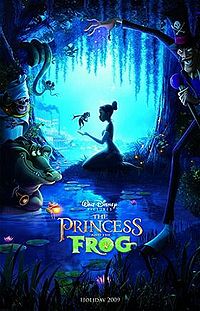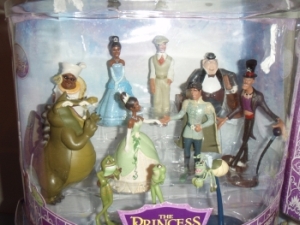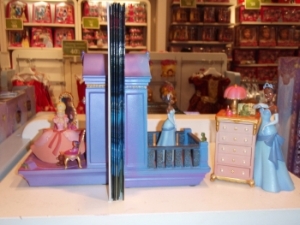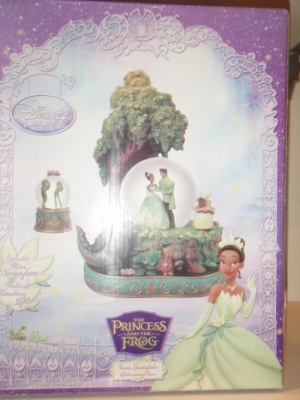Notes on Disney's "The Princess and The Frog"
|
...written with Rebecca Herr Stephenson, Ph.D.
...photos snapped coyly by Amanda Lobely Everyone is talking about Disney’s latest “fairy tale with a twist” The Princess and The Frog. However, a few things seem to be missing from the conversation. Like, where is Maldonia? What sense can we make of Naveen's racial and ethnic identities? How does the film compare to E. D. Baker's novel The Frog Princess or The Brothers Grimm's fairy tale The Frog Prince? While it can’t be denied that Tiana, the African American protagonist, is a welcome addition to Disney’s cadre of princesses, the film is ultimately an argument for post identity politics, self-determination and meritocracy. In a historical moment in which millions of American families are coping with the realities of a troubled economy and widespread unemployment, in which many children spend their days in schools where standardization and the quest for test scores drive instruction, and in which inequalities related to race, gender, class, sexuality, religion and ability continue to be very real elements of young people's lives, is another "bootstrap narrative" really what kids--and adults--need to see? |

|

|
The Princess and the Frog has been described as both a move forward and a step back for Disney. A move forward because Tiana is the first African-American princess and the third non-white princess in the Disney lineup. A step backward because the film is Disney's first 2D animation since 2004's Home on The Range, perhaps making it a nostalgic nod to "reality" as opposed to strict fantasy. As Mama Odie, the blind Voodoo priestess Tiana meets in the Bayou, instructs we aim here to "dig a little deeper." As we dig, we're considering whether the film is a move forward or a step back in ways that go beyond mere entertainment.
|
|
|
Are the film's messages--its depiction of post-Great Depression, segregation-era New Orleans, its representations of identity, and its treatment of transformation and self-determination--really a new narrative or business as usual for Disney? |
||
|
Like most Disney properties, the film is stripped of historical, social, and cultural context. What is unique in this case is that life is attempting to imitate Disney's art as political pundits explain that we've entered a post-racial and post-feminist reality. As for the film, adult viewers are cued to the general time period of the story by a quick glimpse of a newspaper headline announcing Wilson's election. This is interesting because Wilson served when the U.S. was in similar economic meltdown to our own and Obama is sometimes compared to him. This clue is not, of course, accessible to young audience members who do not read or who have not yet studied American Presidential history. Characters' dress and the film score provide other general clues about time period and setting. However, any politics associated with the historical, social, geographical or cultural contexts--for example, the pernicious segregation laws that would have made Tiana's diverse restaurant clientele impossible--are omitted from the story. Instead, the film focuses on the power and importance of one's individually-determined family and friends; constructions which make poverty a cause for song and make racism and sexism minor bumps in the road that can be overcome with individual hard work.
The axis around which this world turns is transformation, however, like the film itself, the transformation need only be skin deep. Our argument is that The Princess and The Frog does not live up to its utopian multiracial promise. We claim that the film is best considered an exercise in race-changing for marketing's sake, particularly because two African American girls are now living in the White House. Racialized transformations abound, as Dr. Facilier, a racially ambiguous man of mysterious origins manipulates reality to suit his ambitions, and persuades others to join him in these pursuits. His victims are not just the princess and the frog, but Lawrence, Prince Naveen's butler who is tired of being a second-class citizen. Together, Facilier and Lawrence attempt to change their fortunes. Lawrence will pass as Naveen and raise his status and Facilier will attempt to repay a massive debt he owes to the spirit world. Of course, nothing goes according to plan and Naveen's "one-drop" of (mixed race?) blood is required to sustain the metamorphosis. As Lawrence's masquerade proceeds, his authentic self begins to leak and obese body parts protrude ala The Nutty Professor. Eye color changes as characters' evil intentions emerge, when characters like Lawrence and Facilier are misbehaving their eyes are blue and violet instead of brown. |

|
The goodhearted characters experience even more profound racial changes. Tiana and Naveen are transformed from humans into frogs so that they can learn the valuable lesson of taking responsibility for their lives by lowering their expectations. The frog couple decides that being frogs won't stop them even if the world wants to stamp them out. They then learn that they can love one another because they are finally the same color, green. Thus, the tacit message is that the marginalized can "magically" change their situations by making a post-identity turn. He are the magic words: if we declare that race doesn't matter, then it doesn't. This spell can be
|
|
|
cast only in a world stripped of historical, cultural, and social context with characters, from places like Maldonia and Louisiana's Bayou, whose physical transformations hinge on ambiguity. Even though Tiana's and Naveen's racial and, to some degree class, identities are stabilized as frogs gender problematics creep in. For example, when they gather and make food in the bayou Tiana, as frog, wears an apron and does the cooking. She displays her domestic prowess while Naveen, also as a frog, makes a clumsy, apron-less attempt at chopping vegetables. This "girl power" moment is turned around when, in return for the cooking tips, Naveen offers to teach Tiana to dance. Despite earlier insistence about not dancing, Tiana agrees, providing audiences with a new version of this classic trope of Disney princess films, in which a dance with a prince reveals a girl's true beauty and leads her to the the solution to all her problems.
Ultimately, Tiana is faced with a choice similar to that of the Disney princesses before her: which is more important, her dreams or her prince? The answer to this question becomes obvious due to the lack of context left in the story. Tiana does not have to make this decision as an African American during a contentious period in history, as a young professional, or even as a marginalized member of society (since there appears to be no status hierarchy among the animals and humans in the Bayou). As a frog, the only remaining salient element of Tiana's identity is her gender; as a female character in a heteronormative narrative, the extent of Tiana's control over her life is limited to decisions about her romantic relationships. The decision to remain as a frog in order to maintain her relationship with Naveen, then, becomes simple: abandon the life she aspired to as a human in order to remain in her newfound post-identity fantasy. As Tiana states, "My dream would not be complete without you in it." As assurance that Tiana will not revert to her earlier "unruly" performances of femininity and race (i.e. enjoying being single, challenging expectations held for her based on her race, aspiring to be a business owner and chef), Tiana and Naveen are married among their self-determined family in the Bayou, planning to live out their days together in the swamp. Tiana's submission to a post-identity reality does not last long, as her marriage to Naveen confers her with the title of princess and transforms her to a human princess, complete with tiara, tiny waist, and poofy ballgown. In keeping with the myth, Tiana now has the power to transform Naveen back to his human form--power that was, ultimately, received due to her willingness to "dig a little deeper," let go of her dream and identity, and accept instead the power offered to her by a post-racial, traditional notion of femininity. The human world to which Tiana and Naveen return, now as a multiracial married couple, is as colorblind as the Bayou--fortunate for them, but unrealistic for audiences. Their hard work and love for one another is all they need to get the restaurant (now called "Tiana's Palace," rather than "Tiana's Place," as she had previously planned) up and running and find themselves dancing in the moonlight on the veranda. |
||

|
The most disturbing implication of this film, in our opinions, is that it promotes ideas like colorblindness, meritocracy and the ability to determine one's own destiny over real-life institutional issues like historical and contemporary oppression and social and political place. Thus, audiences are presented with the message that responsibility for social uplift and/or social change always belongs to the disempowered. So, what do we make of this message? Is it a marker of how far we've come or a sign of how far we still have to go? How do parents help kids understand the text? How do children use the film to help them understand themselves in this world? Should the colorblind ethnic marketing and cross-selling spawned by the film be supported (i.e., hair products, typical Disney fare for girls and then girls of color, soundtrack)?
Stay tuned for answers to these questions and others in our upcoming article for Communication and Critical Cultural Studies. In the meantime we're interested in what you think. Please share your thoughts with us by commenting on this piece. Thanks. |
- Add new comment
- 31510 reads


Submitted by Anonymous on Wed, 01/27/2010 - 09:52.
Great analysis
The best analysis of "The Princess & the Frog" I've read so far! I'm going to Tweet it.
Uwoka Mugabo